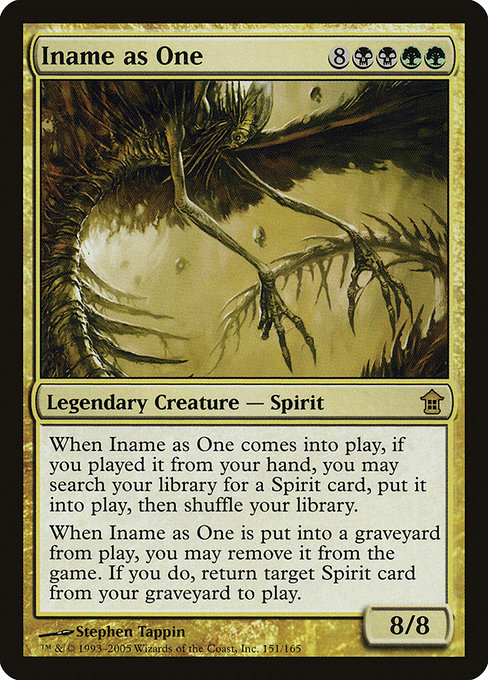
Image courtesy of Scryfall.com
Embedding-Driven Card Similarity: Grouping MTG Cards with Iname as One
Welcome, fellow planeswalkers and data jugglers. Today we dive into the magic of embeddings—the way clever ML models translate thousands of card traits into a vector you can compare with a cosine, a clustering elbow, or a well-timed detour into the graveyard. In MTG terms, imagine turning every card into a constellation of color identity, mana cost, creature type, power/toughness, text quirks, and even flavor notes. When you run that through an embedding model, you start seeing natural groupings emerge: Spirit tribal engines cluster with other Spirit-focused cards; high-CMC legendary creatures find themselves in their own rarefied neighborhoods; artwork, rarity, and set all whisper hints about how a card might slot into a given deck or archetype. 🧙♂️🔥
As a case study, let’s lean on a legendary Spirit known for its gravity and dramatic flips of fate: Iname as One from Saviors of Kamigawa. With a mana cost of {8}{B}{B}{G}{G} and a formidable 8/8 body, this iconic behemoth sits at the intersection of power, parity, and posture. Its presence in an embedding-friendly catalog is not just about raw stats; it’s about what it enables when it hits the battlefield and when it finally departs. Iname as One enters the battlefield with a little Kamigawa-era drama: if you cast it from your hand, you may search your library for a Spirit permanent and put it onto the battlefield, then shuffle. It’s a librarian’s dream and a mid-game swing in one robust package. ⚔️
But the real heart of the grouping comes when Iname dies. The card’s death trigger opens a channel to graveyard recursion: you may exile Iname as One, then return a Spirit permanent card from your graveyard to the battlefield. That creates a feedback loop of Spirit-on-Spirit interaction that emboldens graveyard-centric strategies. When you’re modeling card similarity, this kind dynamic—“die-and-revive” resilience, plus tribal synergy—tends to pull Iname into clusters with other Spirits, particularly those that reward you for building a Spirit-friendly board state or for reanimating from the grave. In embedding space, you’re not just looking at a single card; you’re tracing a network of related plays, archetypes, and deckbuilding aesthetics. 🧠🎨
From a design perspective, Iname as One embodies a few MTG constants that embeddings love to surface. First, the color identity—black and green—pulls it into a broader camp of graveyard-aware, value-focused, creature-heavy strategies. Black offers resilience and recursion; green provides mana-smoothing options, big bodies, and ramp-friendly synergy that can help you reach that monumental 12-mana investment sooner than you might think. Second, the legendary Spirit type anchors it to Spirit-focused shells, which often rely on powerful enter-the-battlefield and synergy-triggered effects to outpace opponents who might be prepared for more straightforward beatdowns. Third, the rare slot signals a design space where big payoffs justify heavy mana costs—an invitation to build around and to seek foil and non-foil variants for collector pride. 🎲💎
“When you map a card’s traits into a vector, you’re basically teaching your deck to think in acronyms—the same signals that said, ‘Spirit tribute engine,’ ‘graveyard revival,’ and ‘big-than-life body’.”
For players exploring embedding-driven grouping, Iname as One serves as a sturdy anchor point. It’s the kind of card that can spark a wave of recommendations: find other Spirits to maximize the ETB fetch; pair with graveyard-returns to sustain pressure; or lean into a heavier mana curve with card-draw and protection to ensure that your massive investment pays off. The practical takeaway is that a single card—especially a build-around legendary like Iname—often becomes a hub around which multiple similarity clusters turn. This is the essence of using embeddings to group similar cards: you’re not just counting traits; you’re discovering how those traits combine to shape play patterns, deck identities, and even financial appeal for collectors. 🧙♂️🔥
At the collector level, Iname as One’s foil and nonfoil finishes, paired with Saviors of Kamigawa’s distinctive art direction by Stephen Tappin, add another layer to the embedding story. The rarity and the dramatic artwork invite comparisons with other big-booted legends and Spirit-themed champions from Kamigawa-era blocks, enriching the network of connected cards that a thoughtful clustering approach will reveal. The end result is a more intuitive map of MTG’s vast card universe—one where you can locate a “Spirit recursion engine” cluster, a “graveyard payoff” cluster, and a “massive finisher” cluster, all around the anchor that is Iname as One. 🎨⚔️
For readers curious to explore these ideas beyond the page, the product ecosystem around MTG resources, e-commerce drops, and deck-building tools continues to grow. And if you’re thinking about practical ways to test embedding-based groupings with your own collection, start with a lightweight dataset of Spirit cards, Legendary Spirits, and big-mana finishers from Saviors of Kamigawa and nearby sets. See how the clusters shift when you emphasize ETB search interactions versus graveyard recursion, and watch as the deck-building story unfolds in elegant, vectorized form. The future of card similarity isn’t just about the next flashy rare; it’s about understanding how relationships between cards shape gameplay itself. 🧙♂️💥
To explore related gear that keeps your MTG fandom on full display while you dive into data-driven play, check out our featured product below. It’s a small reminder that great design—whether it’s a card or a phone case—thrives when form and function align, just like a well-tuned deck aligns with a well-timed fetch land. 🔥💎
Slim Phone Case for iPhone 16 Glossy Lexan Ultra-thin
More from our network
- https://crypto-acolytes.xyz/blog/post/unearthing-playstations-forgotten-mascots-across-generations/
- https://crypto-acolytes.xyz/blog/post/ps2-sports-gaming-legacy-classics-that-shaped-an-era/
- https://transparent-paper.shop/blog/blog/post/textures-impact-on-viewer-retention-in-ads/
- https://blog.digital-vault.xyz/blog/post/dr3-refines-stellar-parameters-for-a-hot-scorpius-beacon/
- https://blog.digital-vault.xyz/blog/post/design-lessons-from-undead-servants-creation/